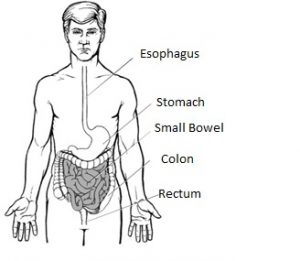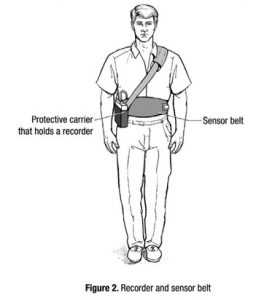Capsule Endoscopy
A small bowel capsule endoscopy is an examination that views the inside of your small intestine (bowel). See Figure 1. It is commonly done if other tests and examinations cannot find the source of gastrointestinal bleeding. It also is done to help diagnose other medical conditions and diseases that involve the small bowel.
Figure 1. Digestive system. Small bowel (small intestine) is shaded.
This information explains what typically happens for a small bowel capsule endoscopy. If you have any questions or concerns about this information, talk with a member of your health care team.
Before the examination, talk with the health care provider who ordered this examination about possible risks. One risk is capsule retention. This means the capsule does not pass through the digestive system and may need to be removed with surgery or endoscopy.

Equipment
You wear equipment (Figure 2) for the entire examination, which is either 8 or 12 hours.
The equipment includes:
- A recorder inside a protective carrier that is strapped over your shoulder.
- A sensor belt that you wear around your waist.
- A wire (antenna) that connects the recorder to the sensor belt.
Rarely, antenna patches are placed on the abdomen and secured with adhesive pads. A wire from each antenna patch connects to the recorder.

Capsule
For this examination, you swallow a capsule that contains a tiny video camera and a wireless, radio transmitter (Figure 3). The capsule is about the size of a large vitamin. It is made of nontoxic material that is not affected by stomach acid and digestive enzymes.The capsule moves through your digestive tract by normal intestinal muscle activity.
You will not feel the capsule pass through your digestive tract.
The camera has lights and enough battery power to take thousands of color pictures as it passes through your small bowel. Pictures are collected by the recorder.

The Examination
Your health care team helps you put on the equipment. The camera and radio transmitter in the capsule are turned on and tested. Then you swallow the capsule with a drink of water. The capsule’s coating, when mixed with water, becomes slippery and easier to swallow.
Equipment
- Do not take off any of the equipment during the examination. You may loosen the sensor belt to go to the bathroom.
- Do not let any of the equipment get wet.
Diet
- Do not eat or drink anything during the first two hours after you swallow the capsule.
- Two hours after you swallow the capsule, you may drink water or any clear, colorless liquid that looks like water. This can include clear carbonated beverages, clear tea, white grape juice or clear broth.
- Four hours after you swallow the capsule, you may drink any liquids and eat a light meal or snack such as soup and a sandwich. Avoid seeds, nuts, fruits, vegetables or salads.
- You may resume your regular diet eight hours after you swallow the capsule.
Medications
- Do not take medications during the first two hours after you swallow the capsule unless told otherwise by your health care provider.
- Two hours after you swallow the capsule, you may take any necessary medications by mouth.
- If you have diabetes or take blood thinners and are unsure about when to resume taking your medications, talk with the health care provider who ordered this examination.
Activity
- You may leave the procedure area and move around.
- Do not exercise, engage in vigorous activities, lift heavy objects, bend, or stoop until after you remove the equipment at the end of the examination.
- Stay away from strong electromagnetic devices such as magnetic resonance imaging (MRI) or ham radios until after you pass the capsule.
- You may use computers, stereos, radios and cell phones.
- You may drive.
- You may return to work if it is compatible with the previously noted restrictions.
When to get medical help
Get emergency medical care if you have:
- Chest pain.
- New abdominal pain.
- Nausea or vomiting.
The End of the Examination
Usually, the capsule reaches the lower end of the small bowel in 8 to 12 hours and later passes with a bowel movement. However, it may pass before 8 hours. Time varies because everyone’s digestive system is different.
If you see the capsule in the toilet before the time you were told to remove the equipment that is noted on page 5, remove all of the equipment and put it into the bag given to you. Do not retrieve the capsule from the toilet. You do not need to return it. You can safely flush the capsule down the toilet.
Otherwise, at the time noted on page 5, remove all of the equipment and put it into the bag given to you.
Bring the bag of equipment to the desk where you checked in for your small bowel capsule endoscopy. If you do this examination while staying in the hospital, leave the bag of equipment in your hospital room.
Examination results
Pictures collected by the recorder are transferred to a computer and evaluated by your health care team. Talk with the health care provider who ordered the small bowel capsule endoscopy about how to get your results.
Possible Capsule Issues
If you do not pass the capsule within 12 hours, the capsule may take up to three days to move through your digestive system. You can safely flush the capsule down the toilet.
If you do not see the capsule in the toilet within two weeks, contact the health care provider who ordered this examination. You may need an X-ray to confirm the capsule is no longer in your body. If the capsule does not pass through your digestive system, it may need to be removed with surgery or endoscopy.
Do not have magnetic resonance imaging (MRI) until you are certain the capsule has passed; either you saw it in the toilet or an X-ray confirmed the capsule passed.

